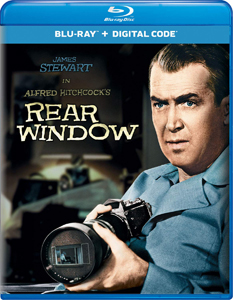A lot of single-apartment movies from the early decades of film feature a rear-projection backdrop out the window (1948’s “Rope”) or are shot from the non-window angle (“Dial M for Murder,” from earlier in 1954). So it must’ve been a revelation for viewers of “Rear Window” (1954) that people are moving about outside the window of L.B. Jefferies (James Stewart).
What’s more, these dwellers of a half-dozen apartments in view of the wheelchair-bound Jeff are doing specific things and they are full-fledged characters — even though most of them never speak, at least not so we can clearly hear them, as they are too far away.
A bigger world opens up
A larger world was opened up to moviegoers in 1954, but – like so many of Alfred Hitchcock’s elite films – “Rear Window” is not stuck in its time. Jeff’s camera equipment — such as flash bulbs — is of the time, but easily understandable to a modern viewer.

“Rear Window” (1954)
Director: Alfred Hitchcock
Writers: John Michael Hayes (screenplay), Cornell Woolrich (short story)
Stars: James Stewart, Grace Kelly, Wendell Corey
The most “of the time” social element is that Jeff’s detective friend Tom (Wendell Corey) is obsessed – judging by eye movements Hitch emphasizes — with the fact that Jeff’s girlfriend Lisa (pronounced Leeza, and played by “Dial M for Murder’s” Grace Kelly) has brought her nightgown. Combined with Jeff’s earlier playful mention to Lisa that he’s supposed to notify his landlady about overnight guests, we’re cued to the mores of the time, so we get a history lesson rather than confusion.
“Rear Window’s” main plot is that one of the neighbors within Jeff’s line of sight (Raymond Burr’s Thorwald) is acting suspicious and has perhaps murdered his invalid wife, cut up her body and disposed of the body parts.
But its secondary point – emphasized in the very slow-burn first half – is romantic relationships, lifestyles and the way people act different (even bizarrely) if they believe they aren’t being observed. Jeff’s nurse (Thelma Ritter’s Stella) is at first blush a Yoda of relationships, telling Jeff he should marry Lisa, simply because they love each other. It worked out for her and her husband.
Logistically, marriage doesn’t make sense for Jeff, as he is a world-traveling photojournalist and Lisa is a big-city fashionista. We’re made to think Stella is wise, but in the apartments across the courtyard we see odd relationships that function and traditional relationships that don’t. The movie’s big secret is that Jeff, rather than Stella, might be in the right all along.
Observing isn’t the same as knowing
Before that revelation, “Rear Window” is the 1954 equivalent of what social media is today. Neighbors are aware that they could theoretically be seen, as they draw their shades when they want privacy. As such, we can assume they are OK with being on display when the shades are up. Some are self-confident enough to desire an audience (“Miss Torso,” who practices her dancing in brief clothing) whereas others are too depressed to give a rip (“Miss Lonelyhearts,” who mimics a romantic dinner although she’s alone).

This is a parallel to modern humans’ self-curated social-media pages, with Jeff sitting in as the web-surfer who is comparing himself to others, but is often getting a glorified picture of others (Miss Torso’s various suitors, and the grand parties thrown by the pianist in another unit). If Jeff had low self-esteem rather than the natural confidence exuded by Stewart, “Rear Window” could go down a different path.
Writer John Michael Hayes – working from a short story by Cornell Woolrich – crafts a very flexible premise, which is why I’m excited to watch the two major remakes (the 1998 version with Christopher Reeve, and 2007’s horror film “Disturbia”).
Another way it’s flexible is in the question of whether Thorwald actually is a murderer or if Jeff is crazy. Many films go down this path, often with a female protagonist wondering about her own sanity. It’s such a trope that there’s a whole parody TV series called “The Woman in the House Across the Street from the Girl in the Window” (2022).
You might not like what you find
It’s interesting to think about how the heroes’ actions in “Rear Window” are heroic only because they guessed correctly. Had they guessed wrong, they would’ve been awful, nosy people invading a man’s privacy – and indeed, I have sympathy for Thornton both because Burr portrays him as bedraggled and because he doesn’t know his privacy is being invaded.
Fascinatingly, detective Tom actually lectures citizen Jeff about the Constitutional right to privacy; today, it would likely be the other way around. If it had turned out that Jeff had misread what he was seeing, we’d have to seriously question these invasions of Thornton’s privacy.
Hitchcock perhaps accidentally crafts an early nutshell analysis of the pros and cons of a spy state versus a free state. Jeff’s spying – and Tom’s by-the-book follow-ups based on the fruits of that spying – do lead to a good end. But I wouldn’t say “Rear Window” encourages mass surveillance (Tom says information on what people do in private is often irrelevant or misleading in detective work) or even voyeurism.
We feel a little dirty – and therefore know Jeff does too – when watching Miss Torso, Miss Lonelyhearts and Thornton. We realize by the end that doing so has cut into our peace of mind.
Hitchcock doesn’t settle the Jeff-and-Lisa relationship question (except to say that they are OK with it being unsettled). But he concludes “Rear Window” with Jeff dozing peacefully while facing away from the window. He gets the outside breeze and sounds – the best he can do while immobilized in his apartment – but he doesn’t know the details of what his neighbors are up to. That’s his path to peace.
IMDb Top 250 trivia
- “Rear Window” ranks No. 51 among IMDb’s Top 250 Movies with an 8.5 rating, beating out another Hitchcock/Stewart collaboration, 1958’s “Vertigo” (No. 103, 8.3).
- One Stewart film ranks higher than “Rear Window” — “It’s a Wonderful Life” (1946) at No. 20 with an 8.6 rating.
RFMC’s Alfred Hitchcock series reviews works by the Master of Suspense, plus remakes and source material. Click here to visit our Hitchcock Zone.

